Disclosure: Meeple Mountain received a free copy of this product in exchange for an honest, unbiased review. This review is not intended to be an endorsement.
“Whoa…this is the OPPOSITE of a big, dusty Euro.”
Two friends from my Wednesday gaming group were staring at the board for the new Daniele Tascini strategy game Transgalactica, published by my favorite publisher of the moment, Devir Games. One of those friends saw the game box resting nearby. “And gold foil on the box? NOICE!”
Tascini is best known for his “T” series of heavy strategy games, such as Teotihuacan: City of Gods, Tzolk’in: The Mayan Calendar, Tekhenu: Obelisk of the Sun, Tabunnusi: Builders of Ur and my favorite of the bunch, Tiletum.
The bland, beige look of Tiletum almost feels like the inspiration for the board layout of Transgalactica…which means that there is color, bright colors, almost everywhere you look with Transgalactica.
In most ways, Transgalactica is not a “T” game or a Tascini design…it’s an Edu Valls game, and I mean that as a very sincere compliment. Valls is the illustrator of record here and a bit like Rock Hard: 1977 stole the show for Devir’s 2024 productions, Transgalactica is very likely going to end the year as the best looking game I will get to the table. If not, it will definitely be my favorite illustration style for a strategy game this year, and I think we’ll start this review with a question:
Why the heck are we not talking about Valls in the same vein as other notable tabletop artists such as Vincent Dutrait, Ian O’Toole, Beth Sobel, Miguel Coimbra, Ryan Laukat, The Mico, and others? One look at this game, and I think you will agree that Valls is doing his best to join the conversation.

“That Cover is Gorgeous”
The cover of Transgalactica was on full display at SPIEL 2024, even before the game hit the market. And, even then, I knew we had something based solely on the quality of the cover design.
My colleague Andrew Lynch recently published a review of the game Barbecubes, and he took up most of his space showing off the beauty of that game’s components. I was tempted to do the same thing with the review of Transgalactica, because I cannot stress enough how immersive the game’s art is to a casual fan.
Transgalactica is a worker placement game that plays well. From a gameplay perspective, it didn’t knock the socks off of any of the seven different humans who sat with me across three review plays (two plays at three players, one play at four players). Tascini has made a number of now-classic titles, and my gaming collective didn’t feel that the experience here exceeded the work of Tascini’s best titles: for me, that would be Tiletum, Teotihuacan, and Marco Polo II: In the Service of the Khan.
But what did exceed expectations was the artwork of Edu Valls. Maybe we aren’t talking about him yet because his work has flown under the radar. Valls has done exceptional work with the imagery featured in 3 Ring Circus and Bitoku, two other Devir titles that landed well but don’t have the loyal following of stars like Kyle Ferrin, the illustrator of many Cole Wehrle titles including Arcs.
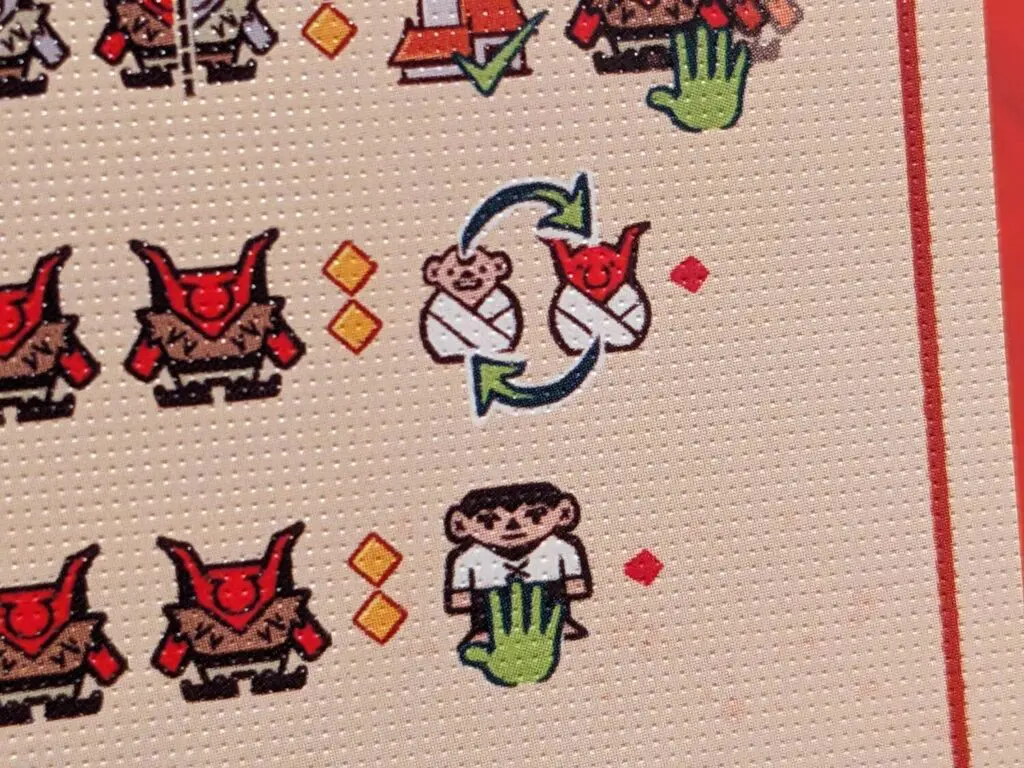
Then I went through the Valls catalog, and it began to line up. Across nearly 150 new-to-me titles, the single best icon I saw in a board game in 2023 was the human-baby-for-troll-swap icon from Trolls & Princesses, a game that flew way under the radar…and that image was a Valls contribution. Valls led the illustrations for Redwood and Chandigarh, two more titles that met the market with mixed results and currently rank in the 3,000 – 5,000 range of ranked titles on Board Game Geek. But looking at the images from those games gives me the same feeling I got when I went through all the images used in Transgalactica.
This guy is good, I thought as I stared at the Transgalactica player boards. Transgalactica uses a lot of images that will be familiar to Eurogame players, but have just enough of an edge to make them look really cool. (The hand-as-income icon in dozens of games nowadays? Yep, it’s here, but it looks like it was inspired by the dark, somewhat horrific hand stirring a cup of coffee used by producer Jordan Peele and his Monkeypaw shingle.)
All this great art means that Transgalactica shines as a production, which elevates its gameplay in fun ways. The initial choice of faction isn’t as dry as “I’ll take yellow” here…now, you’ve got to decide if you want to play as well-drawn humans that look like androgynous space bandits from the 1970s, robots that look a lot like the one-eyed creatures from the Minions films, or handsome pups wearing overalls. (Games can slap almost any theme on any system, so kudos to the entire Transgalactica team for opting out of going full-on dusty Euro and going with something a lot more interesting.)
The iconography work by Meeple Foundry is also excellent; by the end of each of my teach sessions with new players, everyone had a decent feel for the path Transgalactica was trying to blaze because the icons make sense almost right away. This meant that the onboarding for this game—rules and mechanics-light, by Tascini’s standards—was relatively straightforward, both for experienced players as well as a muggle or two I threw into my review plays.
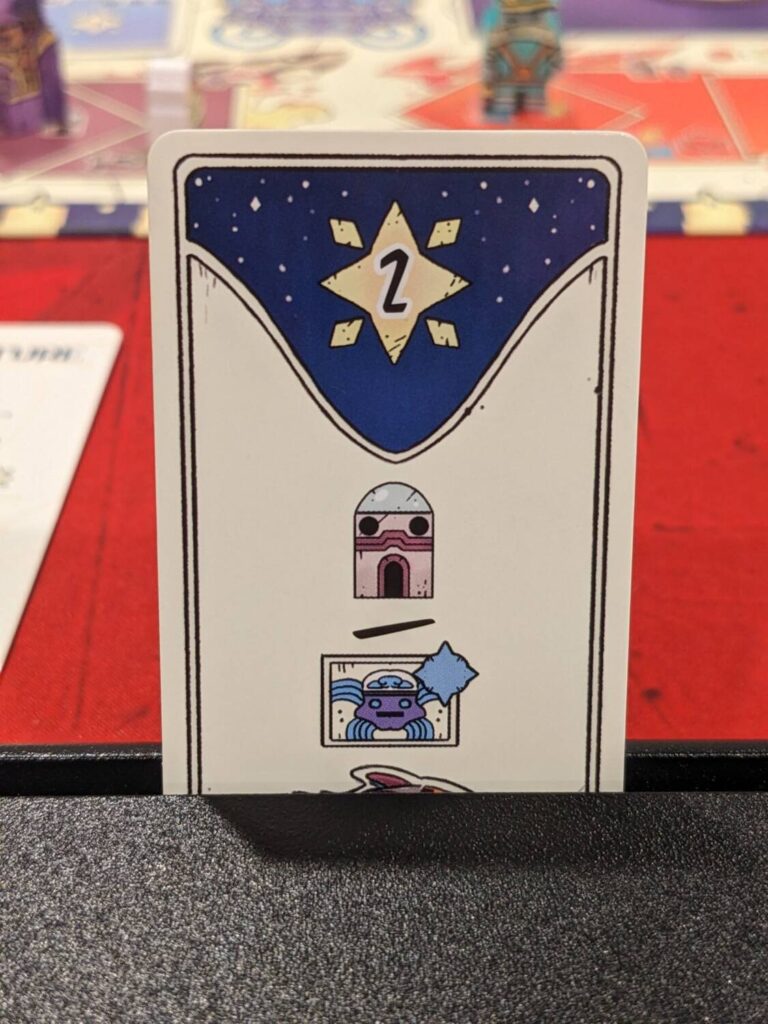
Got It…It’s Beautiful. How’s the Gameplay?
Transgalactica is a 2-5 player worker placement game. The box says it should play in about 20 minutes per player. My experience was more like 30-40 minutes per player, but one assumes this would drop with repeated plays. Each player manages a spacefaring faction that must help expand the boundaries of the Galactic Senate, and to do that, these factions have to explore and settle new planets, discover new technologies and build on their trade and political networks to succeed. (The occasional space pirate must be defeated, too!) After five rounds, the player with the most points wins.
Having just come out of fresh plays of Teotihuacan, and playing Tiletum from time to time over the last year or so, I’ve always enjoyed the designer’s puzzles and Transgalactica is no exception, especially at higher player counts. (Even the manual suggests that initial plays should be done with 3-4 players, but that the game shines brightest at its highest player counts. Of the three plays I did for this review, the four-player game was definitely the highlight.) The game creates a nice level of tension because of the worker placement format, thanks to two types of workers.
Each player has 2-3 captains (tiered to player count), and each captain can take one of the seven main actions scattered around the board. The actions are standard fare—bump up one of the four tracks tied to military strength, production, etc., or take spacefaring actions to boost trade levels, explore new planets or mine for new resources. An eighth action, the Omni action, is simply a wild action allowing a player to copy one of the other seven main actions.
Each player can choose to follow that main action by taking a slightly less powerful, or maybe more expensive version, of the main action, either with one of their captain figures or a crew member. Players begin the game with one crew member unlocked, and during play five additional crew members can be moved from cryo sleep to active duty. Those crew members may not be long for the world, though; while crew can be used to take secondary actions, they are also “perma-killed” in certain cases, such as milestone scoring or to settle some of the planets on the exploration board.
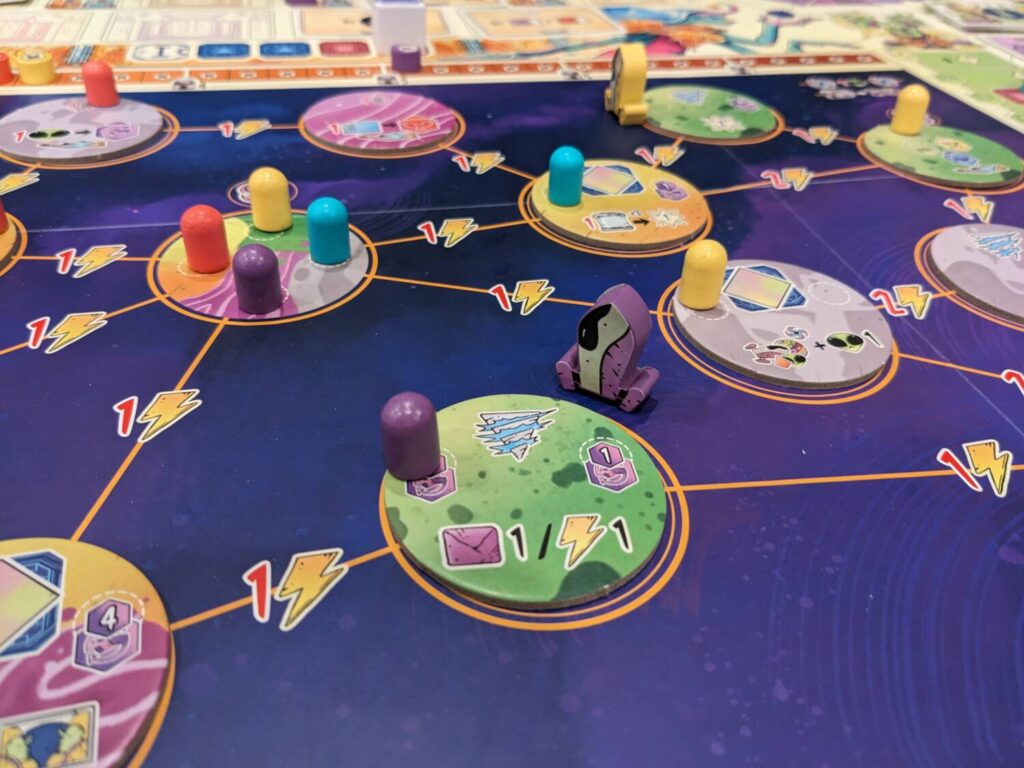
Because main action spaces are blocked by a single captain token, there’s a nice tension when there are four or more players because there are eight main actions no matter the player count. In my four player game, there was a nice amount of drama on every turn, because the game is so short and there’s so much everyone wants to do every round. And players often have varied levels of crew available; in one round, a player might have four crew at their disposal, greatly extending their action selection, while another only has one and claims a milestone action in that same round.
The one novel thing I liked about the Transgalactica design was the income phase, specifically the fact that players earn points based on the number of crew members they do NOT have access to. In rounds where a player only has one crew member, that player earns five victory points to make up for the lack of actions. A player with three crew gets no extra points, but certainly they will have more actions to take in a given round.
Here’s the trick—crew added to the active duty area during the round increases action availability, but doesn’t hurt the owner during the income phase. By my third play, I was craftily finding ways to add a crew member with my first action, then burning that crew member in the same round to settle a planet that required the death of one crew member. In other cases, I was adding a crew member late in the game so that I could claim a milestone that would then unlock another crew member as a bonus.
While Transgalactica isn’t as combo-rich as Tiletum, it has its moments, particularly with the mission cards that players can complete as a free action during their turn. That means turns aren’t nearly as long as Tiletum turns can take, and playing Transgalactica with four players still kept the downtime very low. Transgalactica is generally a very snappy experience given the strategic weight of the decisions, in an environment where resources start out tight and cash (here known as credits) is even tighter.
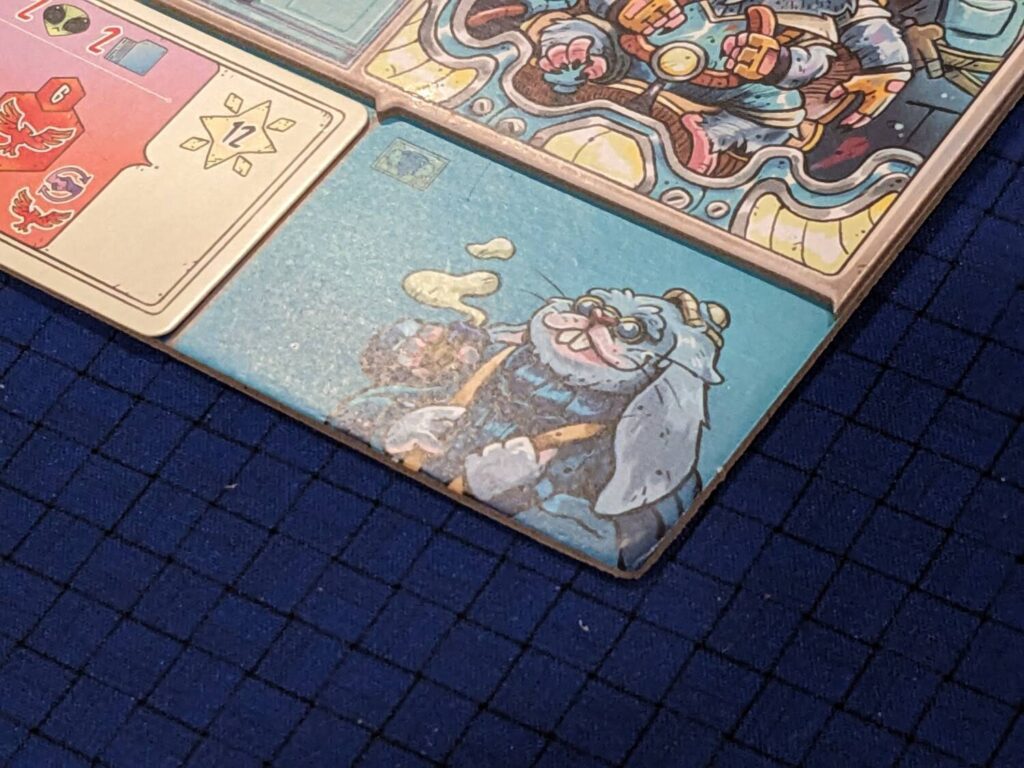
The Techs and the Main Board Layout
Transgalactica stumbled with every group in two main areas: the main board and the technology display.
While the board is gorgeous and features a ton of visual pop, it proved overwhelming to everyone who interacted with it. By the end of each game, most players were able to figure out where everything is and where things should go, but it was not an easy onboard.
There are tracks everywhere. It’s not always easy to see where the worker placement spots are. The game’s technology tracks goes “up” by having players advance their markers down the board, while the politics track goes in the opposite direction when players advance. Three of the tracks start at zero, but the production track starts at one (all players begin play with one outpost). The score track runs around the outside of the board, from zero to 100…but in maybe the wackiest twist of a score track I have ever seen on a board game, there are spaces in-between each point’s space, as if players could score 87.5 points, instead of the reality that there are no half-point scores. (The use of yellow for the score spaces and dark blue for the ‘tweeners confused everyone, and the numbers printed in each yellow space are crazy small.)
The intensity of the main board carries over onto the player boards, and some players struggled with the amount of information available on their personal mats. There’s a track for mining bonuses, politics, income, and trade, but not all that information is necessary at any given time. The marker tracking politics is also a miss; while every other marker can at least claim a comfortable resting place on the player boards, the politics marker sits in an un-recessed space on a single track between income and mining bonuses and regularly moves out of place.
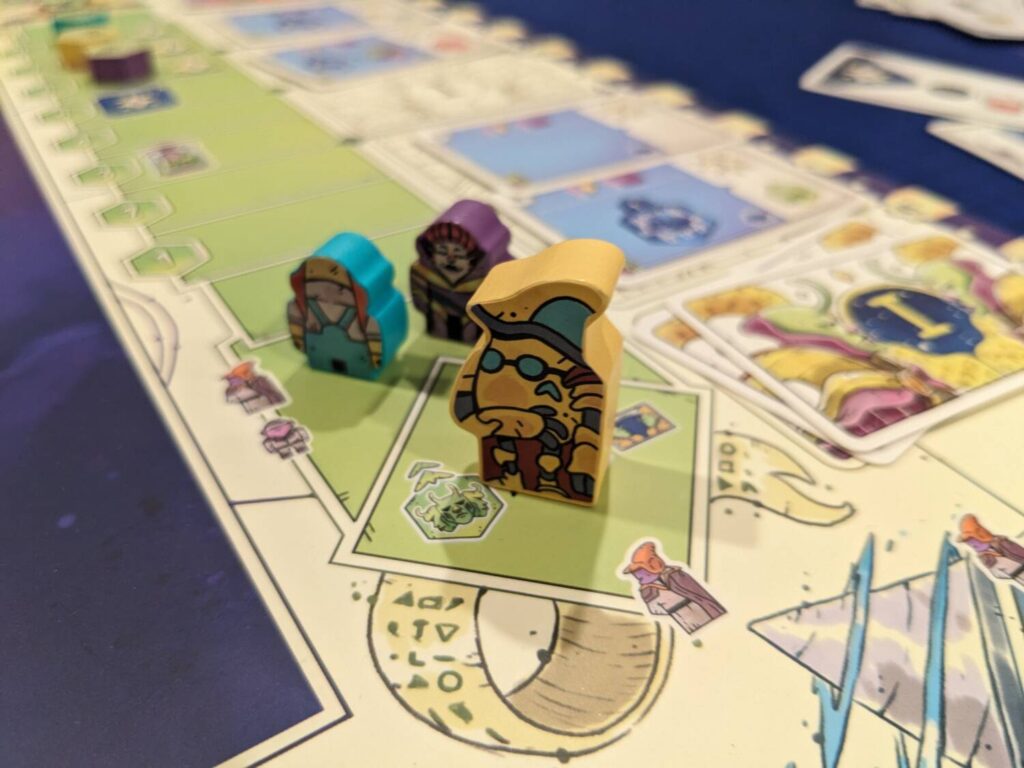
And in one of the very few, if only, times I can remember this being an issue, Transgalactica is a Euro with too many available technologies. Each game features nine techs, from a deck of 30, so the positive here is the crazy amount of setup variability. Each player can claim up to five of the nine techs in each game, and claiming a tech only requires that a player drop a marker in their color on the tech card. (Technologies are never blocked, so claiming a tech does not gate that tech to anyone else.)
Issues with the technologies surfaced almost immediately in each play. The tokens cover the technology, so if four players grab the same tech, it’s not easy to tell what tech is underneath. The tech area is on the far left side of the board, and some players not sitting near the tech display will quickly forget which technologies they have access to. Multiple players forgot about their techs, so they occasionally forgot about scoring opportunities or ongoing powers. And some of the level three techs feature rich scoring opportunities…and you’ll want to know what’s available if you are sketching out your gameplan.
Another bug surfaced in my third play—the highest score I achieved (also the highest score I saw across the three plays) came when I completely avoided the technology area, choosing instead to move up that track to grab one-time bonuses earned by passing certain spaces in that region of the board. Chasing the end-game scores certainly felt like the best path, even if I never got as far up that track as I would have liked.
So I’m torn on the techs. In games like Transgalactica, I usually love bonus powers, but that wasn’t the case during my plays. While I do love the variable player powers that can be drafted by each faction during setup (and some of those are truly a blast, like the one that gives a player a specialized crew member who can take main actions from the secondary action space), the in-game technologies were a minor letdown.
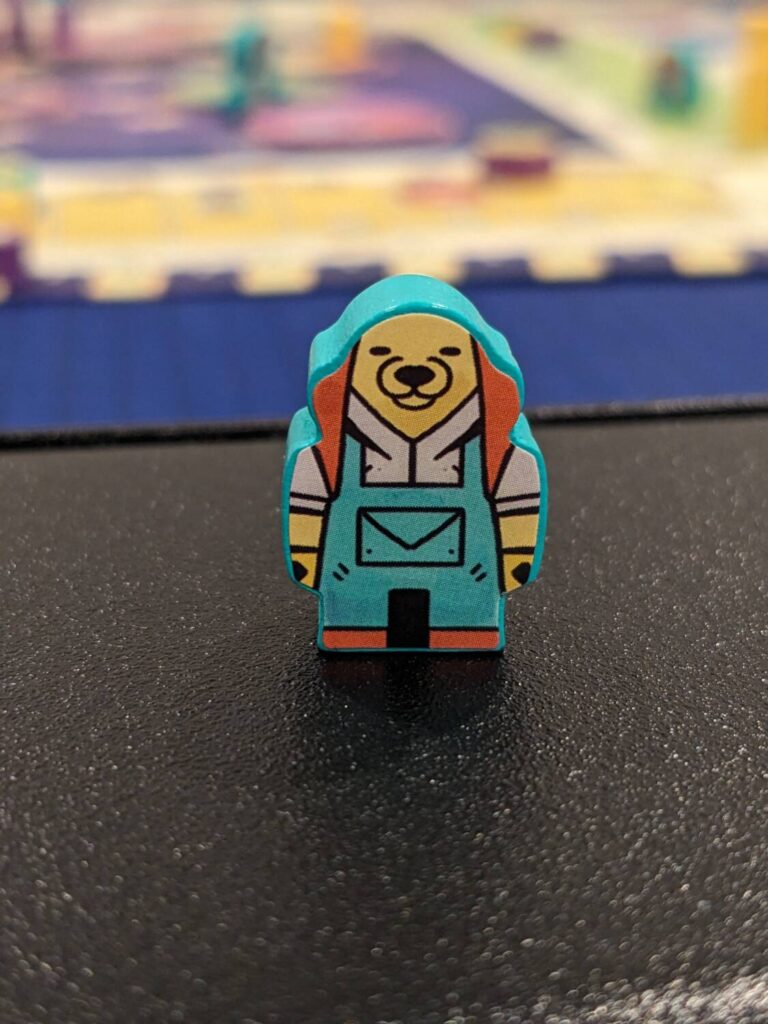
Come for the Production
Transgalactica is a tricky one. While I recommend giving this a spin, I will caveat that with some strict guard rails:
- Play this game with at least four players. While the playtime will run north of two hours, all players will have plenty to do and the tension around worker placement spots will definitely be tight.
- Tascini fans: this is “light” for a Tascini design. Think The Voyages of Marco Polo or Tiletum. If you are hoping for Tascini’s next Tekhenu or Tabannusi, this isn’t on the same level of strategic depth. I found that players could be competitive even if they didn’t have a long-term plan when play began, and even as the most experienced player at the table, I lost two of the three games I hosted. I like that quite a bit—games that favor the most experienced player usually lead to less-than-ideal outcomes—but hardcore strategy players I know like being able to master a complex design and smoke new players.
- Consider house-ruling a couple of game concepts:
- Transgalactica is one of those games where players can earn a bonus tile from a pool of other tiles simply by reaching or passing certain spaces on a track (Minos: Dawn of the Bronze Age being a recent example of this bonus mechanic). Here, players have to take the top most tile. All the core hobbyists who joined me for plays wished that players could choose from the pool to take one that is most beneficial given the timing of when they reached certain spaces…and I tend to agree that this is the better approach.
- On my next play, I will have players take a technology card into their tableau when they earn new techs. Then I will replace those technologies with other cards from the deck. This way, players will remember which techs they have and when they will trigger, from a vantage point much more advantageous to their table position: the spot right in front of their action area.
One other note about the production: Transgalactica comes with three sheets of stickers used to add flavor to the large batch of included wooden components. Do not hesitate—sticker everything. (Well, almost everything; the stickers for the outposts didn’t survive the first night, so I dumped those. And the energy tokens are lightning bolts, so I skipped those stickers too. But I used the rest.)
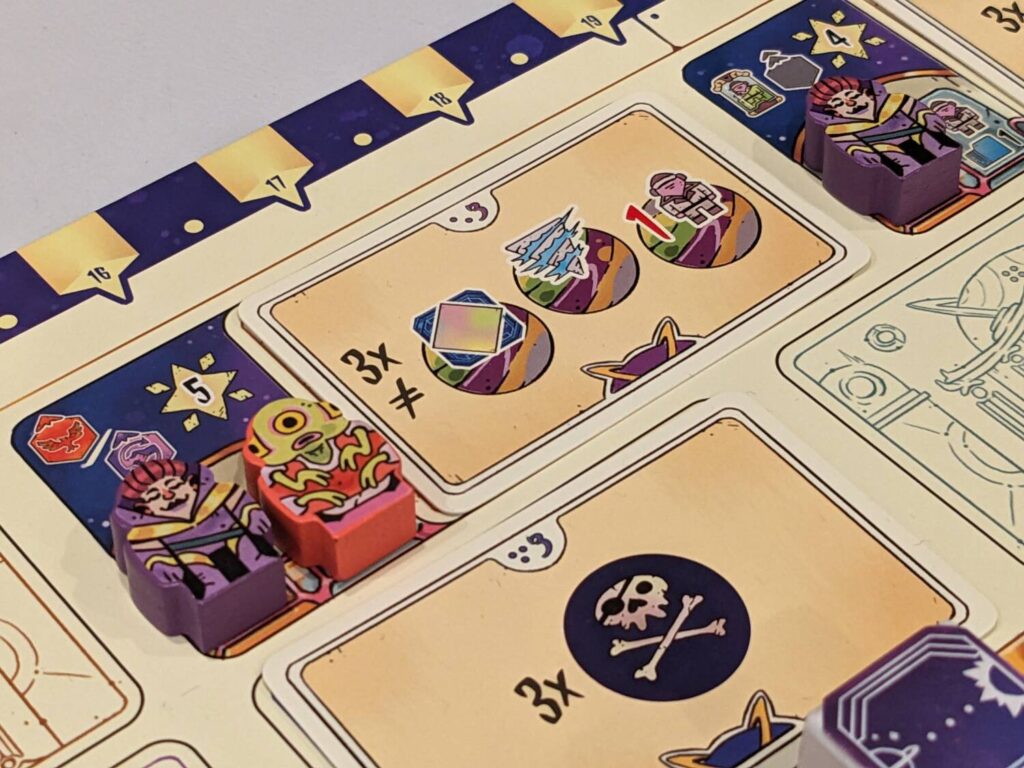
The stickers add a very nice dynamic to the pieces. A bit like the stickers included with the Bitoku components, I love when stickers on characters include both a front and a back side sticker. The dog overall stickers are glorious. The stickers for the spaceships are great too. Take an hour to put all the stickers on…it’s a minor pain but very worthwhile.
Transgalactica gets a lot of things right, even if the gameplay generally feels familiar. The sheer variety in player setup, particularly around the 10 included player powers, already has me excited for future plays. For my game nights with five experienced gamers, I am definitely going to have Transgalactica ready to go; it’s easy to teach, the worker placement is tight, and the game does a nice job of conveying the feeling that you are leading a motley crew on missions across the galaxy.
I’m rooting for this game to sell well because I think expansion content will be a nice way to keep Transgalactica in the rotation. If you enjoy a good worker placement game steeped in some of the best artwork in the galaxy, Transgalactica is absolutely worth a look!




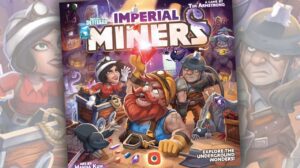




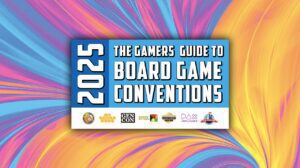

Add Comment